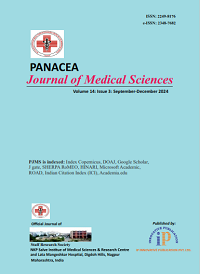Dysmorphic RBCs in chronic kidney disease: Can it determine the extent of glomerular damage?- An institutional experience
DOI:
https://doi.org/10.18231/pjms.v.15.i.1.42-47Keywords:
CKD, Dysmorphic RBCs, eGFRAbstract
Introduction: Chronic kidney disease (CKD) is a global health concern, associated with rising risk factors. Glomerular filtration rate (GFR) measures renal function, crucial for prognosis. Dysmorphic red blood cells (RBCs) in urine, indicating glomerular issues, might correlate with serum creatinine and estimated GFR. This study explores their potential as accessible markers for renal function assessment. Materials and Methods: The year-long study at KR Hospital, Mysore, involved 40 diagnosed CKD patients. Urine analysis, collected in a sterile environment, underwent phase-contrast microscopy. Hematuria and dysmorphic RBCs (<25>25%) were assessed. Serum creatinine levels were measured, and eGFR calculated using a formula. Inclusion criteria covered diagnosed CKD cases aged >20, excluding those <20. Descriptive statistics, including frequencies, percentages, mean, and standard deviation, were calculated for the variables. Results: The study examined 40 CKD patients aged 22 to 92 (mean age: 51.8). The majority of cases were observed in the 10-20, 30-40, and 50-60 age groups. Males accounted for 52.5%, with a higher average age compared to females. Dysmorphic RBCs were present in 80% of cases. Conclusion: There was no significant correlation between the presence or percentage of dysmorphic RBCs and serum creatinine or eGFR levels. The distribution of dysmorphic RBCs across different eGFR levels showed no significant association.Downloads
Published
2025-03-12
Issue
Section
Articles
How to Cite
Dysmorphic RBCs in chronic kidney disease: Can it determine the extent of glomerular damage?- An institutional experience. (2025). Panacea Journal of Medical Sciences, 15(1), 42-47. https://doi.org/10.18231/pjms.v.15.i.1.42-47





